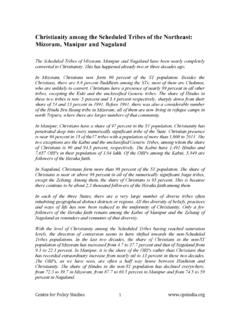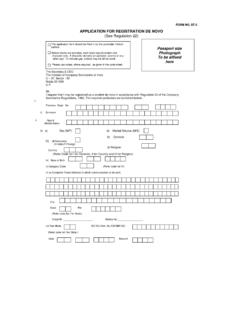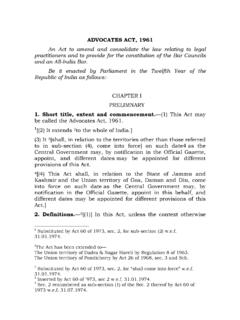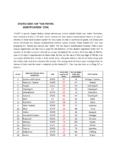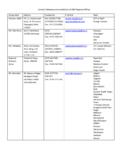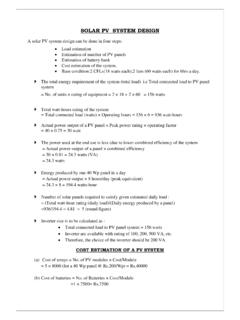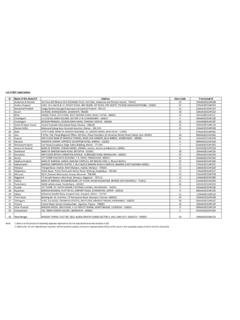Transcription of Role of Self Help Groups (SHGs) in Rural …
1 IOSR Journal Of Humanities And Social Science (IOSR-JHSS) Volume 22, Issue 7, Ver. 5 (July. 2017) PP 27-31 e-ISSN: 2279-0837, p-ISSN: 2279-0845. DOI: 27 | Page Role of Self Help Groups (SHGs) in Rural Development with Special Reference to Chare, Longkhim and Sangsangyu Block under Tuensang District, Nagaland Therila Sangtam, Dr. Sangyu Yaden (Research Scholar, Department of Geography, Nagaland University:Lumami, India) (Professor, Department of Geography, Nagaland University:Lumami, India) _____ Abstract: Rural Development is a very dynamic process which involves in improving the socio-cultural, environmental, political and economic well-being of the Rural poor living in relatively isolated areas. In a country like India where majority of the people are living in Rural areas, the concept of Rural development assume great significance.
2 The Tuensang district is one of the most backward district in Nagaland where poverty, illiteracy, lack of skills and health care, basic infrastructure etc are prevalent in all the villages. After the inception of Self Help Groups (SHGs) approach by the North East Rural Livelihood Project (NERLP), the SHGs have been playing a vital role to eliminate these problems through the way of group efforts, especially the women folks. The self help group SHGs approach is a new instance into the field of Rural development which aims at improving the living condition of the Rural poor by creating sustainable community based institutions. Keywords: North East Rural Livelihood Project, Rural development, Rural poor, Self Help Groups , Women. I. INTRODUCTION Rural development is the process of improving the quality of life and economic well-being of people living in relatively isolated areas.
3 The concept of Rural development is very important for a country like India, where majority of population is under Rural areas. For such a country, development in the true sense can be achieved only when the Rural areas are developed. In order to change the face of socio-economic scenario of the Rural areas, Self Help Groups comprising of women, working under the aegis of North-East Rural Livelihood Project (NERLP) is playing a vital role in Tuensang district. The NERLP is a multi-state central sector World Bank funded Rural poverty reduction project. The main objective of the NERLP for forming the SHGs in the Rural areas is based on forming community institutions of the poor as opposed to institutions for the poor. The SHGs are informal Groups in nature where members come together towards collective actions for the common cause. SHGs act as the building blocks of organizing poor and disadvantaged households in the community.
4 The vision behind SHGs approach in a village is to promote self-reliant and a collective women force towards increase economic and livelihood opportunities in a sustainable manner. The SHGs of these three blocks - Chare, Longkhim and Sangsangyu under Tuensang district is contributing a lot towards economic development and livelihood opportunities of the Rural poor since its inception in 2013. The SHGs of these blocks have been able to organize and marginalize the Rural poor to come together for the development of the Rural areas through common efforts. II. STUDY AREA The study area for the present research work is confined to the SHGs of the three blocks - Chare, Longkhim and Sangsangyu under Tuensang District, Nagaland. These are the 3 blocks among 9 Rural Development Blocks of Tuensang District. The study area lies between 25 50 N to 26 30 N latitudes and 94 30 E to 95 10 E longitudes.
5 Chare block has 12 villages with 2039 households. Longkhim block has 12 villages with 3272 households. Sangsangyu block has 24 villages with 4419 households. Chare and Longkhim block comprise of Sangtam Naga community while Sangsangyu block comprise of Chang Naga community. III. OBJECTIVES To find out the different income generating activities of SHGs. To find out the pattern of income from each economic activities. To examine the role of SHGs in Rural development. Role of Self Help Groups (SHGs) in Rural Development with Special Reference to Chare, Longkhim .. DOI: 28 | Page IV. METHODOLOGY The present study has been based mainly on primary data. Out of the 3 (three) blocks Chare, Longkhim and Sangsangyu, two villages from each block were selected as the sample villages and all the SHGs in these villages were taken into consideration.
6 An extensive field survey was conducted through a prepared schedule and informal interview with each SHG Groups in the sample villages as well as with the District Micro-Finance NERLP, Tuensang. Thereafter, an analysis has been done on the basis of simple statistical tools and technique. V. FINDINGS AND DISCUSSION The concept of Self Help Group got a major impetus after the North-East Rural Livelihood Project, a multi-state central sector World Bank funded Rural poverty reduction project aims at improving the Rural livelihoods especially that of women, unemployed youth and the most disadvantaged, in four participating North Eastern States was launched. Nagaland is one of the participating State among the four North-Eastern States under this Project. At present only Tuensang and Peren are under NERLP since 2013. The present study was conducted in 3 blocks-Chare, Longkhim and Sangsangyu under Tuensang district, selecting 2 villages from each block.
7 All together there are 71 SHGs in the sample villages, each SHGs consisting of 10 members. Around 710 women were engaged in the SHGs in the 6 sample villages during the field survey in 2016-17. Table 1. Showing the Number of SHGs in Each Sample Villages. Block Name Sample villages No. of SHGs Chare Alisopur 31 Longkhitpeh 11 Longkhim Lirise 14 New Mangakhi 5 Sangsangyu Khudei 7 Helipong 3 Source: Field Survey 2016-17 Since the year 2013 a large number of village people particularly women have been mobilized into self help group in the study area. The beneficiaries were selected on the basis of total population of the village, by selecting one member from each household in order to include the entire village households in the development process. To understand the dynamics of self help Groups , the following heads has been considered for the present study: Income generating activities of SHGs The self help group (SHG) approach is a new instance into the field of Rural development which aims at improving the living condition of the Rural poor by creating sustainable community based institutions.
8 It would give a new platform for the women to actively participate in the process of development through diverse livelihood activities by managing the natural resources. The self help Groups in the present study area are engaged in various income generating activities. The activities of the SHGs are generally based upon traditional know-how and availability of local resource base. It was found that the beneficiaries of the SHGs consisted only of female members unlike other SHGs which consist of both male and female members. And most of the activities of the SHGs are primarily associated with agrarian economy. Table 2. Showing the Total Number of SHGs and Beneficiaries in Each Income Generating Activities in the Study Area. Income generating activities No. of SHGs No. of beneficiaries Piggery farming 25 250 Ginger Cultivation 14 140 Small Business 10 100 Handicraft & Weaving 9 90 Potatoes Cultivation 7 70 Poultry Farming 5 50 Rajma Cultivation 1 10 Source: Field Survey 2016-17 Role of Self Help Groups (SHGs) in Rural Development with Special Reference to Chare, Longkhim.
9 DOI: 29 | Page : Showing the Total Number of SHGs and Beneficiaries in Each Income Generating Activities in the Study Area. Some differences have been observed in the practice of income generating activities in present study area. Out of 71 SHGs and 710 beneficiaries in the sample villages, 25 SHGs were engaged in piggery farming followed by ginger cultivation -14 SHGs, small business-10 SHGs, handicraft & weaving-9 SHGs, potatoes cultivation-7 SHGs, poultry farming-5 SHGs and rajma (red kidney beans) cultivation-1 SHGs respectively. Thus, 7 different types of income generating activities were found in the present study area such as piggery farming, ginger cultivation, small business, handicraft and weaving, potato cultivation, poultry farming and rajma cultivation. The proportion of the self help Groups in different income generating activities in the study area is shown below ( ).
10 It can be observed that 35% of the SHGs were under piggery farming, 20% of SHGs under ginger cultivation, 14% of SHGs under small business, 13% of SHGs under handicraft & weaving, 10% of SHGs under potato cultivation, 7% of SHGs under poultry farming and 1% of SHGs under rajma cultivation. : Proportion of the Self Help Groups in Different Income Generating Activities Source: Field Survey 2016-17 Pattern of income from each economic activity The self help Groups in the study area are funded and supported by the North-East Rural Livelihood Project (NERLP). In order to manage the self help group a sum of 20,000/- was given to each SHGs as one time grant. Thereafter, a sum of 120,000/- was given as inter-loaning amount to each SHGs. A total of 140,000/- has been given to each SHGs for a period of five years. The inter-loaning amount is regulating among the SHGs beneficiaries with an interest rate of 2% per month.










